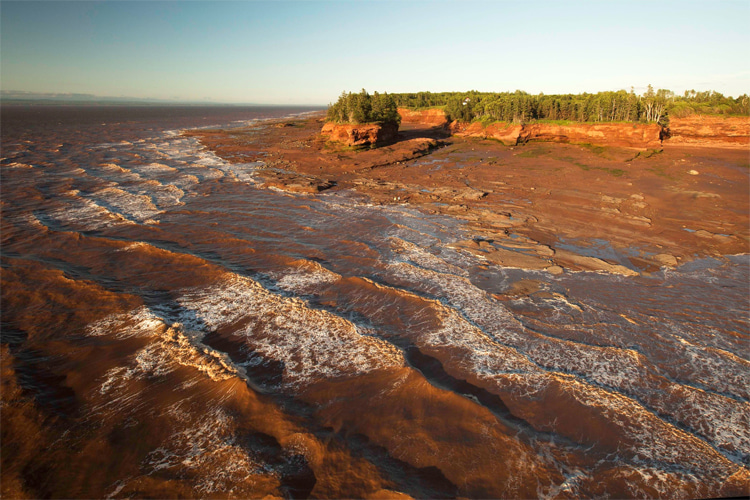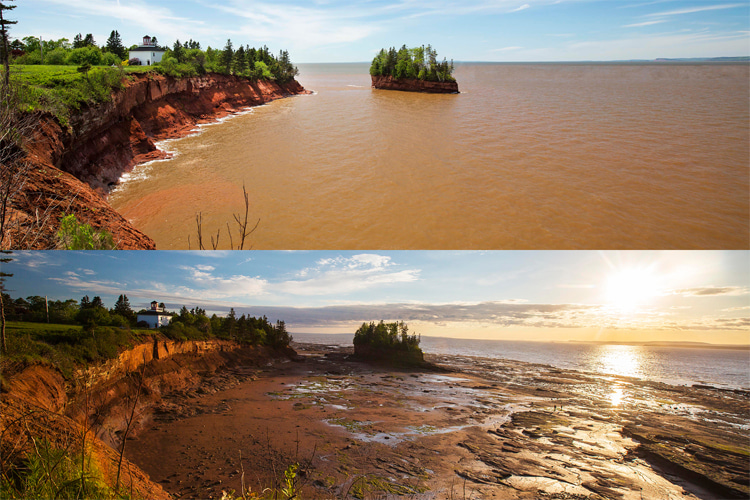There is a place on Earth where the difference between low and high tide reaches 53.6 feet (16.3 meters). It's the Bay of Fundy in Canada. You've got to see it to believe it.
Imagine that you're swimming or stand-up paddling in the ocean and near a five-story seaside building.
You get in the water at noon, and at 6 pm, you're out. By the time you get your feet on terra firma, you're on the rooftop of the same building.
It's not a dream or a sci-fi movie. It's basically what happens in Canada's Bay of Fundy, home to the world's highest tide and tidal range.
Burntcoat Head Park, a small rural community in Hants County, Nova Scotia, is the exact point where you can witness this extraordinary tidal phenomenon.
In 1975, the Guinness World Records noted the 160 billion tonnes of water that flows in and out of the funnel-shaped Bay of Fundy twice a day.
To put things into comparison, that's three times the total flow of all the world's rivers in the same period.
The Bay of Fundy is 400 meters long and features an average depth of 246 feet (75 meters).

Erosion and Surfing
At Burntcoat Head, the average high tide is also surprisingly extreme at 47.5 feet (14.5 meters).
The world's largest tidal range creates unique natural features exposed to dramatic dry and wet environments every six hours and 13 minutes, on average.
One of those are the Hopewell Rocks (also known as the Flowerpot Rocks), towering rock formations sculpted by tidal erosion over thousands of years.
The Bay of Fundy is also home to diverse marine life, including whales, dolphins, seals, and various species of seabirds.
The region is popular with tourists and tide watchers, who check the tide tables for the best time to experience the extreme semidiurnal tidal ranges and explore the ocean floor.
Several regional rivers have tidal bore waves, i.e., waves that travel against the natural river flow.
One of the most popular is the Petitcodiac River.
On July 24, 2013, Colin Whitbread and JJ Wessels, two surfers from California, rode the Petitcodiac River tidal bore wave from Belliveau Village to Moncton, New Brunswick, for 18 miles (29 kilometers).
The adventure took two and a half hours.

The Pendulum Effect
The world's highest recorded tides at the Bay of Fundy are caused by a combination of several variables, including the gravitational pull of the moon and sun, the rotation of the Earth, and the area's unique funnel shape matching the Atlantic Ocean tides' pulse.
However, the most important factor is tidal resonance.
"A simple example of resonance might be a swing that you're pushing," explained Dave Greenberg from the Bedford Institute of Oceanography.
"The length of the bay might be proportional to how long the rope is on the swing, and that will determine the period."
"If you push a swing at exactly the right period, you can start off slowly and keep it going with just a little bit of force, and it's the same sort of thing in the Bay of Fundy."
So, the water in the Bay of Fundy rhythmically sloshes back and forth like a child in a swing.
This sloshing happens to occur at the same frequency as the Earth's tides.
And because the time between consecutive high tides matches the time it takes a wave or a swell to go from the mouth of the Bay of Fundy to the very end and back, we witness these incredibly high tides and low tides.
Tidal Power
This incredibly active pendulum effect attracted interest in a renewable energy project.
The Annapolis Royal Generating Station was a tidal power generating station located on the Annapolis River in Nova Scotia, Canada.
It was one of the first tidal power plants in the world and was constructed in the 1980s to harness the powerful tides of the Bay of Fundy.
The station utilized a tidal barrage system, which consisted of a dam with sluice gates that allowed water to flow into and out of the river basin during tidal cycles.
As the tides rose and fell, the water flow would drive turbines, generating electricity.
The Annapolis Royal Generating Station had a capacity of 20 megawatts and provided renewable energy to the local power grid.
However, the station faced various operational and environmental challenges, including concerns about its impact on fish migration and sedimentation within the river basin.
After several decades of operation, the Annapolis Royal Generating Station was decommissioned in 2019.
